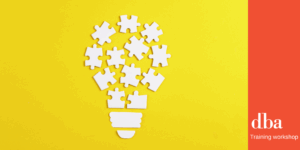Main Content

Rediscovering the creative brief
For the last year, whenever possible, I’ve been asking agencies whether they write creative briefs. That’s the document that takes the client’s brief and translates it into something that can inspire a creative team. I’ve had mixed responses. Some agencies are not bothering, for others it’s an occasional event, and hardly any are going one stage further and getting the creative brief agreed and signed off by the client prior to starting work.
It seems to me that, somewhere along the line, the importance of the creative brief has been lost. Within agencies, it’s often seen as a bit of a chore, a piece of admin, just a form to be filled out. In my view, there is a general lack of understanding as to its proper role and value.
Our latest ‘What Clients Think’ report reveals that 30% of clients wish their agency would ask more questions and dig deeper, so the first stage in the process is a thorough interrogation of the client’s brief. A typical client comment is, “They should be more challenging around my brief and push back” or “Is it the right thing to do?” and “Challenge what we give them rather than just heads down.” Another is, “I’m obviously not being clear and I accept some of the blame, but they’re the experts and they should be able to drag it out of me.” The last point is key.
Agencies can’t just blame the client for a poor brief. A major part of an agency’s skill set is the ability to ask the right questions and extract the right information before leaping to creative work. After all, an important distinction to remember is that the artist writes his own brief, the designer can’t start without one. Designers need parameters to work within, a problem to solve and an opportunity to seize.
The agency’s questions can usually be grouped into three broad areas. Firstly, there are questions about the problem – the strategic issues being addressed. Secondly, there are questions about the context – competitors and trends. Thirdly, there are questions about deliverables – what we want the target audience(s) to think, feel and do. At brief stage, never be afraid to ask the obvious questions. Now’s the time. As Peter Drucker, the father of modern management consultancy, said, “My greatest strength as a consultant is to be ignorant and ask a few questions.”
Once the questions have been asked and the information gathered, the creative brief can be addressed. Typical creative brief sections include identification of the problem, offer, USP, the audience, application, success factors and practical considerations. Back to my earlier point, though, it shouldn’t just be viewed as a form to be filled in. Instead, the creative brief should be treated as the vital bridge between the client’s world and the agency’s creative team. It acknowledges that both client and agency are united in their objectives, but their skills and ways of looking at the problem are different. In this sense, it should never just be a shorter format regurgitation of the client’s brief. An effective creative brief reduces the client’s brief to its core and turns it into plain English. Remember, designers tend not to speak ‘marketing’ and customers certainly don’t.
That’s not to say that you should be limited by words. Some of the best creative briefs I’ve seen have included images. Images can be more stimulating and more precise than words and, after all, the designer’s currency is visual. Most importantly, though, the creative brief should excite designers. It should spark their enthusiasm and make them feel it’s the best project they’ve ever had.
For those agencies that don’t write creative briefs or have got out of the habit, let’s summarise why all this is important. A good creative brief saves time and money because it should result in fewer amends and revisions. It’s a more efficient way of working. It ensures better decision making because it helps to reduce subjectivity and allows better rationalisation of creative work. It helps the client to recognise great work when they see it. It inspires and motivates the creative team and is more likely to result in high quality, effective and measurable creative work.
Of course, if the creative brief gives an unclear problem, is overloaded with information, mistakes facts for insights, focuses on product/service features not user benefits, relays information but doesn’t translate that or contain a driving thought, then it simply becomes that form to be filled in.
So, how do you know when you’ve written a good creative brief? Well, the clue is in the name. Is it brief? It shouldn’t turn into an essay or a job justification exercise. The skill is in making it concise. Does it focus on one key message? Are you telling a simple, inspiring story? Does it lead the team from the key message, through the insight, to the reason to believe, with each building on the other? Is it clear on immovables and mandatories? Is it jargon free? Will everyone understand it?
Most importantly, does it have designers excitedly heading for the studio?
Don't get lost in translation | DBA online workshop | 3-4.30pm | 4 and 6 November
 Transform your client’s brief into a powerful tool that drives clarity, inspires great work and delivers effectiveness, with this practical two-part course for design professionals.
Transform your client’s brief into a powerful tool that drives clarity, inspires great work and delivers effectiveness, with this practical two-part course for design professionals.
Led by Jonathan Kirk, taking place from 3-4:30pm GMT on Tuesday 4 and Thursday 6 November. Find out more and register now.